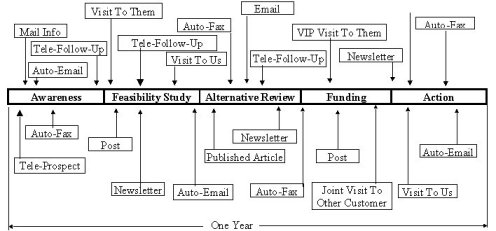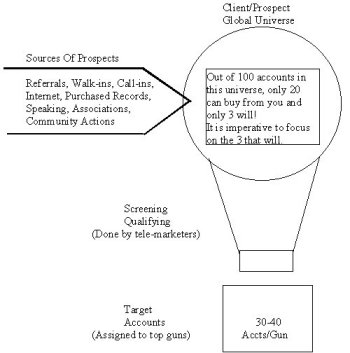
The purchase cycle for a first time business purchase of some significance is not a singular event nor is it just a few singular events. Rather, we have found it to be a process of interwoven and complicated activities that normally stretches over a period of a year! This idea of using a "double-reverse close" or an "assumptive close" simply does not fit for most "Relationship Selling" situations. When our students say they want us to teach them how to close we know they want some magical method for getting orders without the necessary long term effort that is crucial to success. We have found the purchase cycle to look something like the following schematic.

Target clients need to get continuous contacts and an information stream that includes: phone calls, faxes, post cards, personal visits, joint visits, news-letters, PR articles, etc. This kind of activity is what relationships are all about.

Everyone wants an order without any effort. This however, is not realistic.
We must select a relatively small number of
target accounts and get them into the purchase cycle. Even with this tremendous contact
and information stream some potential clients will go to competitors but
without it, most will go to competitors. This is why it is so
important to focus on a relatively few number of customers. It is easier for sales
people to go after hundreds of customers instead of focusing on 20 to 30 accounts.
The new sales person will tell his boss he made contact with many customers but he will
never sell them. Selling involves helping customers and getting to know their
needs. This can only be achieved with many repeat contacts.

We must maintain a global universe of
customers and prospects and tele-prospect them to determine the ones that can
buy from us and the ones that have an interest. Once we have determined
that a prospect has an interest we can move the prospect into the purchase
cycle. Microsoft Access databases
can help enormously in keeping track of all the contacts that have taken place
over time.
We must
have a comprehensive system to find clients, qualify them and move them out or
into the purchase cycle. A small company can have only a couple of hundred
accounts in the target account box.
Lower cost "tele-prospecters" can do a good deal of the screening and
qualifying and then the accounts can be assigned to "top-guns" to
follow up.
There are some things we can do to reduce the purchase cycle, but we should not
plan on making purchase cycle reductions a required activity, since more will go
the full cycle than will not.
� Establish a sense of urgency - this is the key.
� Promotions
that are time limited - offer expires in 30 days.
� Limited
availability - only ten left.
� Delivery
ease - here it is right here and I will bill you later.
� Opportunity
loss avoidance - if you do this now you can take advantage of an opportunity and
will not lose out.
� Cost
continuation reduction - if you do this now your costs will be reduced
immediately.
� Investment
avoidance - If you do this you will not have to buy that.
�
Immediate
sales increase - Doing this now will generate significant sales increases.
� Problem
avoidance - If you buy this now the roof will not cave in.
� Comfort
level exists and trust of your word is enough. I just trust this guy.
� Impulsive
purchase - Just bought it because it looked right.
� Greed -
appeal to a customer's greed. Getting
something for nothing.
� Ego -
appeal to a customer's ego. It's cool to do this.
Copyright 1998 Mitchell Selling Dynamics, Inc.
1360 Puritan Ave, Birmingham, MI, 48009; Phone 1-248-644-8092
1360 Puritan Avenue, Birmingham, Michigan 48009, USA
John Cell Phone: 248-644-8092
John Email: john@mitchellsell.com
© Copyright Mitchell Selling Dynamics Inc. www.mitchellsell.com